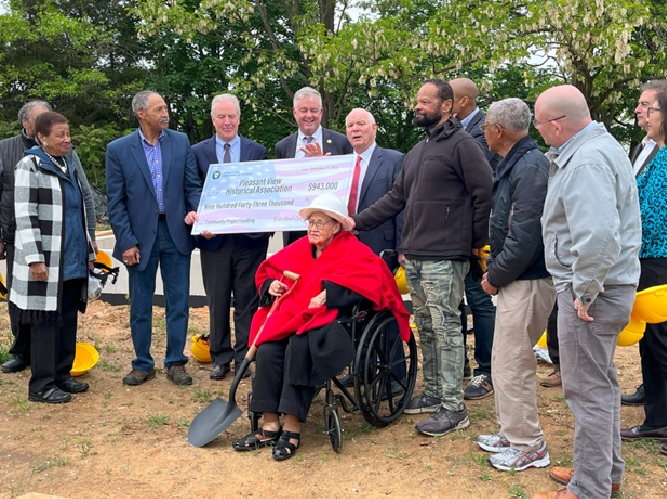Dear Fellow Marylanders,
The term earmark originated with farmers and ranchers who would cut the ears of their sheep, cattle or other animals in a certain way to distinguish them from others and identify ownership. The term made its way into Congress as a way for lawmakers to claim ownership of a specific spending item in the appropriations or spending process.
Today, in the Senate, we call these designated projects Congressionally Directed Spending. The House of Representatives calls them Community Projects. Whatever name you prefer, members of Maryland’s congressional delegation work to secure this federal funding to support projects and initiatives that fulfill needs across the state.
Not everyone has been a fan of earmarks and they disappeared for a full decade. With bipartisan agreement, earmarks returned beginning with Fiscal Year 2022, with stricter rules and more transparency. This renewed authority allows each senator and member of Congress to once again work with local leaders to find out what they need to do their jobs better, help Marylanders in need and help our communities become better places to live, work and play.
Earmarks are only 1% of total federal discretionary spending. But they provide a significant opportunity for Congress to respond directly to needs across the state that might not otherwise receive sufficient attention, or to provide critical funding for a project to get started or achieve completion. The EPA Chesapeake Bay Program started out as an earmark for studying the loss of wildlife and aquatic life in the Bay and has since become an essential part of our efforts to renew and maintain the health of our nation’s largest estuary.
As your elected representatives, Team Maryland is advocating for you every day, to make sure that Maryland’s challenges and priorities receive full consideration and ample attention from the federal government. We work together when submitting earmark requests – perhaps unique among congressional delegations nationwide – to maximize the resources available for Maryland projects.
Under the banner of “you can’t get what you don’t ask for,” we request funding each year for more projects than can receive funding. All funding decisions are subject to eligibility guidelines established by the Appropriations Committees and relevant budgetary caps. This is a highly competitive process and the stronger the case for the funding, the more likely it will clear each stage of consideration. Now in its third year under the new rules, I can report that Marylanders are getting pretty adept at earmark project writing.
Even in instances where projects are not able to receive funding during the current fiscal year, the earmark vetting process has helped foster fruitful conversations between communities and Team Maryland about local aspirations and other pathways for advancing progress on priorities, including other potential federal grant opportunities.
The return of earmarks brought with it the opportunity to visit and learn even more about the great work being done through worthwhile, local projects around the state. It’s always a good day when I can bring a big check to support Marylanders.
I’ve been traveling the state with my Senate partner, Chris Van Hollen, as well as Maryland members of Congress. To learn more about many of the Maryland Congressionally Directed Spending projects we have requested for FY24 and the projects that received funding for FY23 and FY22, please check out this dedicated page on my website: https://www.cardin.senate.gov/issues/earmarks-congressionally-directed-spending-requests/. It will be updated throughout the Appropriations process as we learn what specific projects will be funded for FY24.
Here is a sampling of some of the great programs I have been able to visit recently:
New Shiloh Community Development Corporation received federal funds that will be used to support the construction of a new community center serving the New Shiloh Village and Greater Mondawmin area. It will have a variety of sports, recreation, tutoring and mentoring programs for local youth.

Senator Van Hollen, Congressman Kweisi Mfume and I delivered big checks to a number of local nonprofits at this same visit, including: L.A.M.B., Inc. Community Development Corporation (CDC) in East Baltimore for The Haven and Rosa’s House; The Star Community Family Life Center in Baltimore County; Transforming Lives Community Development Corporation STEMcx Workforce Development and College Readiness Program; Liberty Community Development Corporation Food Pantry; The Mary Harvin Community Development Corporation Southern Views Multi-Family Workforce Housing Project in Baltimore City; WBC Community Development Corporation Forest Park Renaissance; and the Jewish Community Services Living Group Home renovations.
In Gaithersburg, we were excited to bring federal funding to the Pleasant View Historical Association, which is restoring and preserving deteriorating structures that are part of the Pleasant View Historic Site, which served as a center for the rural African American community in Maryland for more than 100 years.

Anne Arundel County received a number of federal earmarks, including funds to help grow our local small businesses and our regional economy, protect our environment, strengthen regional transit, provide essential resources for the community, and preserve Maryland’s rich history.

On the Eastern Shore, I was pleased to present ceremonial earmark checks to Chesapeake College for workforce training programs, including computer and robotic skills and expansion of the welding program – a highly in-demand skill – with a Mobile Welding Training Lab designed to reach students where they live and work. Earmarks also went to the Building African American Minds Academic Center in Easton, The Arc Central Chesapeake Region Port Street Facility, and the Boys & Girls Club of Cambridge.

In Western Maryland, we met some of our youngest constituents while presenting a ceremonial check to the Asian American Center of Frederick’s early education program, which helps provide culturally relevant and language appropriate education services to young Asian American students.

Prince George’s Community College received federal funding to expand and enhance both its registered nursing (RN) associate of science degree and certified nursing assistant (CNA) programs. This will build and enhance pathways to successful careers in nursing for hundreds of students and better positioning the state of Maryland to meet its growing and changing healthcare needs.


The City of Bowie was presented this month with an earmark to rejuvenate Allen Pond Park. The largest in Bowie, the park is a hub for middle-income residents of all ages as it provides sport fields, an entertainment venue, cultural events, and exercise space.

While visiting Charles County, I delivered a check for the Town of Indian Head that is redeveloping vacant lots into a much-needed grocery store, a planting garden and a raingarden with parking spaces that will help the surrounding resources such as the Indian Head Rail Trail, Riverwalk and other community events.
These are just a sampling of the wide array of federal investments we are making across Maryland based on local needs and priorities. I am proud to support programs that help fill gaps and spur meaningful growth in our communities.
Thank you for your time. Please feel free to email me about this or any other issue you would like to discuss. I always appreciate your emails and notes.
Sincerely,

